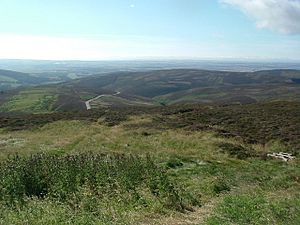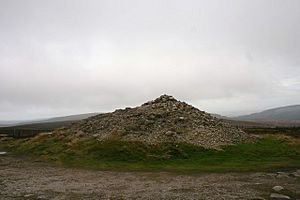Cairn O' Mounth facts for kids
Cairn O' Mounth (also called Cairn O' Mount) is a high mountain pass in Aberdeenshire, Scotland. Its name comes from an old word, "Mounth," which was used for what we now call the Grampian Mountains. In the Scottish Gaelic language, "monadh" means "mountains." The name "Cairn O' Mounth" likely refers to a stone pile (a cairn) found in the pass.
This pass has been an important route for a very long time, even since Roman times. It was used by armies and travelers up until the 1200s. The way the Cairnamounth, Elsick Mounth, and Causey Mounth old paths were set up actually helped decide where many castles and towns were built in Aberdeenshire, especially near the River Dee.
Exploring Cairn O' Mounth

Cairn O' Mounth is about 1,493 feet (454 meters) above sea level. From here, you can see amazing views of the land around you, stretching all the way to the North Sea.
Before the modern A90 road was built, this pass was one of the main ways to cross the Grampian Mountains. People used it to travel to Deeside and further into Northern Scotland. This whole old route was known as the Cairnamounth. A small village even grew up in the pass because of all the travelers.
Today, the road through the pass is called the B974 road. A tall, rocky hill called Clachnaben overlooks this road. The Scottish Tourist Board says the B974 is an "adventurous" road. It can be hard to use in winter because of snow or floods.
A Look Back in Time
The Cairn O' Mounth pass has seen many important historical events.
Macbeth's Retreat
In the 1000s, Mac Bethad (who you might know as Macbeth) used this pass. After being defeated by Máel Coluim mac Donnchada in 1057, Macbeth and his men retreated over the Cairnamounth Pass. He made his final stand at a battle near Lumphanan. Some stories say he was wounded there and died later at Scone.
Armies and Ancient Paths
The Cairn O' Mounth pass was also used by Edward I's English army in 1296 as they returned to England. Later, in 1689, Viscount Dundee's army used this route twice during a Scottish uprising.
The path over the pass is likely very old, possibly from prehistoric times. There is a stone pile, or cairn, in the pass that is about 4,000 years old (from around 2000 BC). It's possible this ancient cairn is the one that gave Cairn O' Mounth its name.


